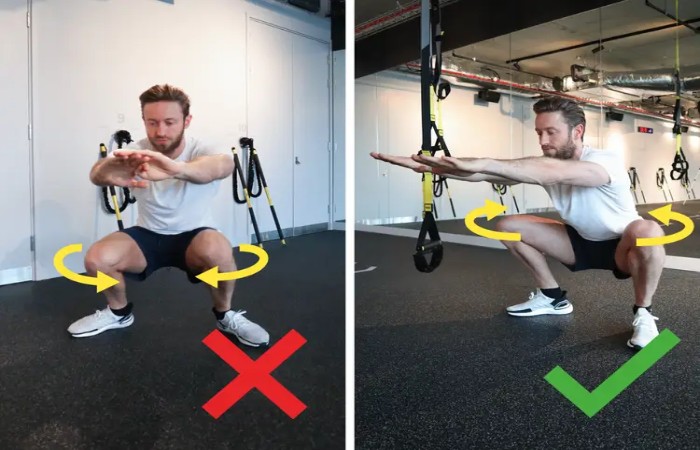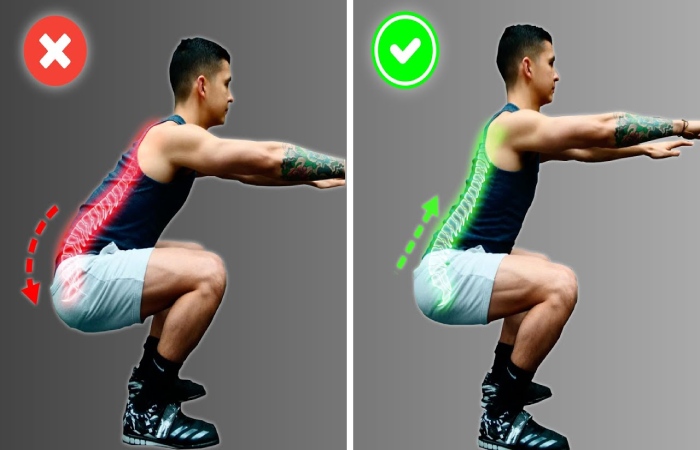Squats are a fundamental exercise for any fitness routine, catering to weight loss, endurance, power, strength, and overall fitness goals. Their widespread appeal lies in their simplicity, making them suitable for beginners and seasoned athletes.
These versatile exercises effectively engage numerous muscle groups, including glutes, hamstrings, quadriceps, calves, and erector spinae, while also promoting knee and ankle joint strength and health, preventing age-related discomfort. Fitness instructors often use squats to assess strength and flexibility before crafting personalized workout plans. Squats can be performed with or without weightiness, allowing for progression based on individual fitness objectives and physical capabilities.
In this article, we will look at the benefits of Squat Correctly, the correct way to do them, and the mistakes to avoid when performing them.
Table of Contents
Benefits Of Doing Squats

We should highlight squats’ positive effect on health, specifically on the muscles. Especially the legs become more vigorous and increase in size. On the other hand, the tendons and other parts of the lower area are also favored.
Something worth noting, among many things, is that it is an activity that both men and women can carry out. These are other advantages and benefits that Squat Correctly provide, according to coach angel Carmona.
Reduces risk of injury. Thanks to the strength of the muscles, they are better able to perform demanding physical activities without fear of harm.
Reduce fat. Like many other exercises, it helps to eliminate accumulated fat, toning the muscles.
Promotes balance. The type of exercise and the form of its execution help to increase body balance.
How to do Squats Correctly?
Avene
To enjoy all the benefits Squat Correctly provide, performing them properly is essential. Professional trainer Marisa Santos highlights the technique to follow during this activity.
Initial Position
We must first know the position with which the activity will start. This is essential for the subsequent execution to be adequate. To do this, you must be completely upright. The hands will go on each side. The feet should have a distance between them, similar to the performer’s shoulders.
Some people find it more appropriate for their toes to be point forward, while others prefer to suggest as far to the side as possible. On this point, coach Santos points out that there is no strict rule, so each person can choose the option that seems best to them.
Something similar happens with the hands, although in this case, most coaches consider it more appropriate to interlock them with each other. However, if the performer prefers to keep them side by side, with fingers outstretched, there is no problem.
Execution
When performing the exercise, you must be very clear about the form. Some people believe it is about bending the knees to strengthen the legs, but in reality, that must be an effect of the natural movement of the exercise: the area of the waste that goes back.
Breathing
Breathing plays an essential role in performing Squat Correctly. Especially since this exercise helps to strengthen the abdominal area. Therefore, when moving backwards, you should exhale and inhale when returning to the starting position. This makes it easier for the movement to have a much more significant impact on the body.
Repetition
It should be note that it is a continuous exercise, so after throwing the pelvis back, which leads to bending the knees and lowering, you must return to the starting position to repeat the process. The goal is to complete the predetermined number of repetitions.
As a suggestion, you can do ten repetitions, rest 1 minute, and do the same amount again until you complete four series.
Mistakes To Avoid When Doing Squats

Experienced trainer Roger Brown points out these common mistakes when doing squats.
Force The Knees
Squats should demand the most significant resistance from the glutes, not the knees. Therefore, when you throw your waist back, you should feel more pressure on your thighs and buttocks, not your knees or legs.
Misplaced Knees
Once again, if the knees are not moving correctly, the exercise will lose value. To have greater ease when going down, some put their knees in when in reality, they should be out. Only then can you get the full benefit of squats.
Flex Your Back
As damaging as putting the knees, it is flexing the back. To avoid injuries in this area, it must remain straight at the time of the execution of the squats. Among the recommendations of the experts to quickly correct this error is to stare straight ahead, in addition to increasing the relaxation of the shoulders.
Roll Up Your Heels
There is a movement that people usually do when performing squats, especially those who do them for the first time. It is about raising the heels when the pelvis is brought back. It is normal because it is a way to reduce the pressure felt by both the buttocks and the muscles, but it is a mistake and, therefore, should be avoid.
Firstly, because it decreases the effect that Squat Correctly can have on the muscles, and secondly, because if the heels are not fixed on the ground, then when going up, it will be much more difficult. This is because the heels are essential in the push that must be done to return to the starting position.
Finally, it must be taken into consideration that there is a wide variety of Squat Correctly, so it is worth varying, especially if you have already mastered how to perform any of them. In the case of those that require weight for their execution, this should not be too heavy, both to avoid injuries and to get the most out of the exercise.
Conclusion
Squats are a highly beneficial exercise for various fitness goals. They engage many muscle groups, including the glutes, hamstrings, quadriceps, calves, and erector spinae, while strengthening knee and ankle joints. Squats improve lower body fitness, promote proper posture, and help prevent age-related aches and pains. Whether you aim to lose weight, build endurance, or increase strength, squats are a fundamental exercise that can be adapted to any fitness level and provide long-lasting benefits for overall fitness and well-being.
